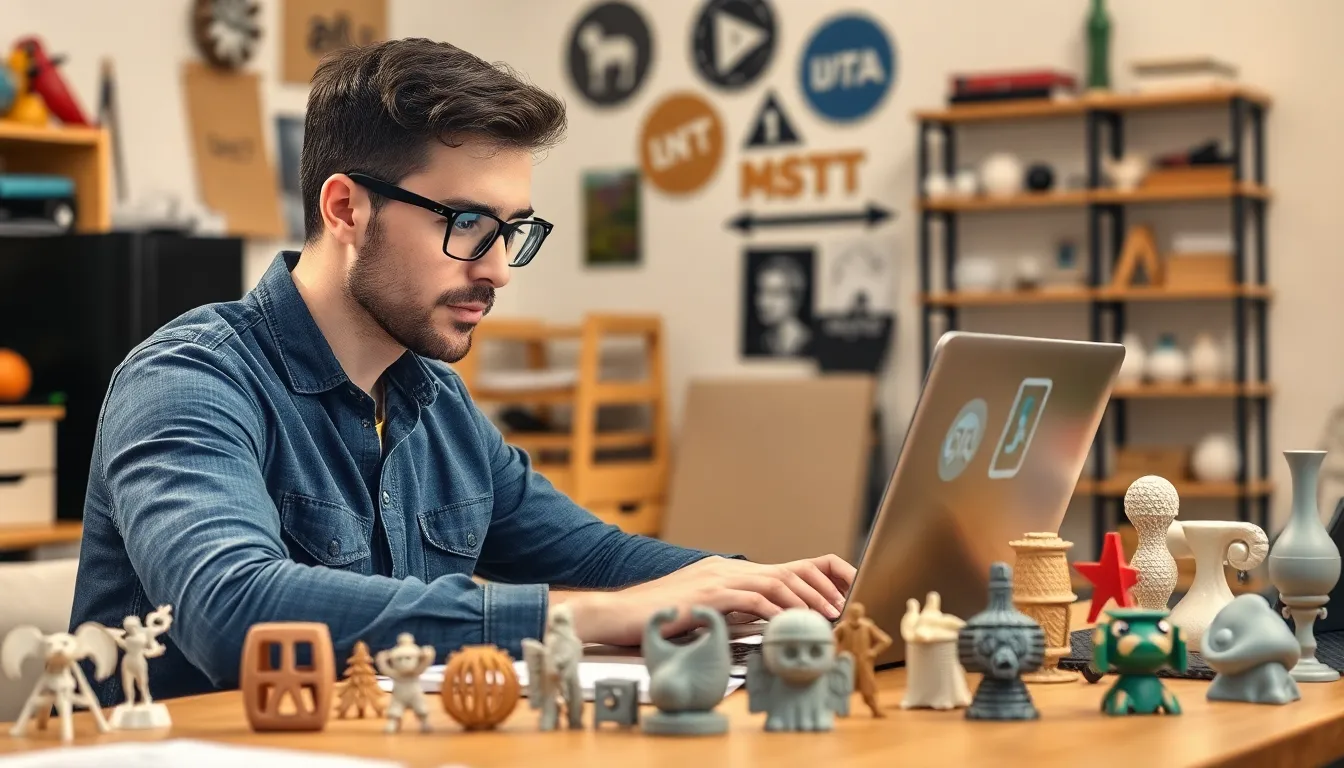In a world where imagination meets technology, 3D printing stands at the forefront, transforming dreams into tangible creations. Think of it as the magic wand for designers, where every idea can leap off the screen and into reality. But before diving headfirst into the printer’s embrace, there’s a bit of know-how that can save time and a few tears.
Table of Contents
ToggleUnderstanding 3D Printing Technology
3D printing, also known as additive manufacturing, transforms digital designs into physical objects. Grasping the fundamentals of this technology paves the way for successful design and production.
Types of 3D Printing Methods
Fused Deposition Modeling (FDM) utilizes thermoplastic filaments, melting and extruding material layer by layer. Stereolithography (SLA) uses ultraviolet light to cure liquid resin into solid forms, enabling high precision. Selective Laser Sintering (SLS) employs a laser to fuse powdered material, building robust and intricately detailed structures. Each method offers unique benefits and constraints, making it crucial for designers to choose the right one based on project requirements.
Applications of 3D Printing
Consumer products benefit greatly from 3D printing, allowing customization and rapid prototyping. In the medical field, 3D printing creates personalized prosthetics and implants, tailored to individual patient needs. Aerospace and automotive industries leverage this technology for lightweight components, improving performance and efficiency. Numerous sectors are also exploring 3D printing for architectural models, educational tools, and artistic creations, showcasing its versatility and innovation potential.
Principles of 3D Design

Understanding the principles of 3D design is crucial for effective printing. Designers must consider various factors when creating digital models for 3D printing.
Software Options for 3D Design
Numerous software options exist for 3D design, each catering to different skill levels and project needs. Tools like Tinkercad offer user-friendly interfaces suitable for beginners. Blender provides advanced features for professionals, enabling complex modeling and animation. Fusion 360 integrates CAD and CAM applications, making it ideal for engineering projects. Other software, like SketchUp and SolidWorks, deliver tailored solutions for architecture and industrial design. Evaluating these tools helps assess which one aligns with specific design objectives.
Design Parameters and Constraints
Design parameters significantly impact the 3D printing process. Dimensions, tolerances, and resolutions directly influence print quality. Designers must account for the material properties, as each material behaves differently during printing. Geometry also plays a critical role; complex shapes may need support structures for effective printing. Weight distribution affects stability, while cost considerations guide material selection. Understanding these constraints ensures optimal design choices are made, leading to successful printing outcomes.
Best Practices for 3D Printing Design
Effective design plays a pivotal role in successful 3D printing. Focusing on key practices enhances the strength, durability, and printability of objects.
Optimizing for Strength and Durability
Choosing the right materials strengthens 3D-printed objects. High-density plastics like Nylon and ABS offer robust properties for functional parts. When selecting designs, prioritizing load distribution leads to better performance under stress. Increasing wall thickness and incorporating reinforcing ribs enhances structural integrity. Geometry also plays a significant role; structures with rounded edges and fillets perform better to withstand forces. Additionally, orienting pieces correctly during printing minimizes stress concentrations, ensuring durability in the final product.
Designing for Printability
Ensuring designs are print-friendly significantly reduces production challenges. Avoiding overly complex geometries simplifies the printing process. Adding supports or using designs compatible with the printer’s technology increases the likelihood of successful prints. Design elements such as overhangs require careful consideration to avoid failures. Using a minimum wall thickness of 1-2 mm generally yields good results while maintaining object strength. Regularly checking for non-manifold edges and ensuring proper scaling aids in achieving high-quality outputs. Employing these considerations enhances efficiency and success rates in 3D printing projects.
Troubleshooting Common Design Issues
Design flaws can hinder the success of 3D printing projects. Identifying these flaws early reduces the risk of wasted materials and time.
Identifying Design Flaws
Common issues include poor dimensional accuracy, inadequate wall thickness, and unsupported overhangs. Designers must analyze models for oversized gaps and overlaps that lead to weak structures. Ensuring appropriate tolerances is vital for fitting parts together. Non-manifold edges can also create problems during the printing process, as they leave parts unprintable. Checking for these flaws using software tools helps streamline the review process and improves overall design quality.
Solutions to Printing Problems
Resolving printing problems involves several strategies. Modifying wall thickness strengthens objects while maintaining printability. Adding supports for overhangs mitigates issues with sagging during printing. Using different infill patterns enhances durability without wasting material. Adjusting print settings such as temperature and speed can also address adhesion issues. Regular calibration of the 3D printer ensures accurate dimensions and optimal performance. Ultimately, a proactive approach to troubleshooting improves print quality and reduces errors.
Mastering the art of designing for 3D printing opens up a world of possibilities. With a solid understanding of the fundamentals and best practices, designers can transform their creative visions into tangible products. By selecting the right materials and optimizing designs for printability, they can enhance both the strength and durability of their creations.
Addressing common design challenges proactively ensures smoother production processes and higher success rates. Embracing these principles not only fosters innovation but also empowers designers to push the boundaries of what’s possible in various industries. As 3D printing technology continues to evolve, staying informed and adaptable will be key to unlocking its full potential.



